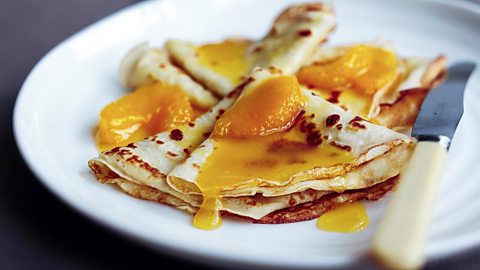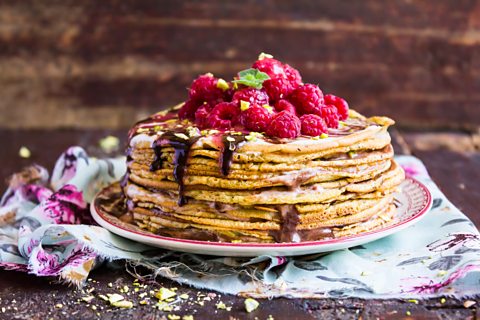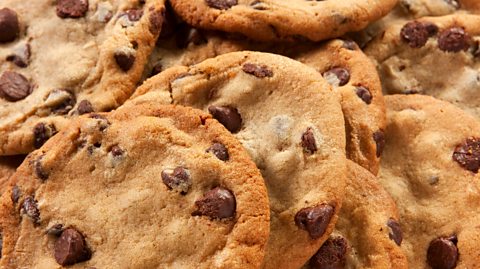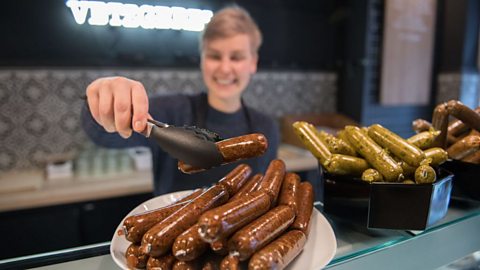Pancakes are not just delicious - they are also very interesting.
When you drop a dollop of bubbling batter in a hot pan and see it turn into a lovely round solid, you are observing science in action. And knowing your science can help you achieve pancake perfection.
Here are some tips grounded in kitchen chemistry, as well as academic research, to help you win at Pancake Day.
1. Like them fluffy? Donãt overmix
Every ingredient in a pancake recipe has a role. Flour, for example, provides the structure of your pancakes. When combined with wet ingredients like milk and eggs, the two proteins contained in flour (glutenin and gliadin) link to form gluten. Gluten ãcapturesã air bubbles, which cause your pancakes to rise. However, this only works for a very short time ã the bubbles can disappear after resting (more on this below).
Stirring your ingredients is really important, as it stretches the proteins, which allows gluten to form. But while very gentle mixing forms almost no gluten, beating your batter until itãs too smooth can make gluten overdevelop. This means the air bubbles will have less space in a more tightly-organised gluten structure, and your pancakes will turn out dense and chewy.
Remember this if youãre making American pancakes, which contain raising agents (such as baking powder). If you have too much gluten, the bubbles will not be able to grow large and the texture may become chewy; on the other hand if there is too little gluten then the bubbles can simply burst leaving a very dense texture.

2. If you prefer them thin, rest your mix
If youãre partial to a crûˆpe, you may have noticed most thin pancake recipes ask you to leave the batter to rest for half an hour or so. That allows the flour to absorb the liquid ingredients and gives the gluten the time to relax. as the protein chains untangle. It also makes the mix more uniform, making it less likely to get holes once itãs in the pan. Remember those air bubbles? When the glutenãs relaxed, air bubbles can work their way out, ensuring your crûˆpe will turn out paper-thin and levelled.
So remember: you want a thick, not perfectly smooth mixture for fluffy American pancakes, and a runny, smooth batter that has been left to rest for crûˆpes.
3. Tilt the pan straight away
Weãve all done it. You pour what will become your first crûˆpe, and tragedy strikes: too thick here, too thin there and, before you know it, a hole.
Luckily, in 2019, fluid dynamics researchers Mathieu Sellier and Edouard Boujo, respectively from New Zealandãs University of Canterbury and Franceãs ûcole Polytechnique, came up with a computer model for making the perfect crûˆpes. Their study looked at how pancake batter increases in viscosity as it gets hotter, in conjunction with the panãs orientation and temperature.
The trick is to tilt the pan steeply as soon as youãve poured the batter, so that the mixture can spread from the centre of the pan to its edges. Next, move the pan (while still tilted) in circling motions, so that itãs all coated in batter. Keep rotating, gradually decreasing the panãs tilt until itãs completely flat, and your perfect pancake is ready to be instagrammed.

4. Flip your wrist, donãt lift the pan
In 2002, a physics lecturer at the University of Birmingham came up with a science-based approach for the perfect pancake flip.
Dr Garry Tungate based his study on a 50 gr pancake, looking at variables such as its kinetic energy, gravity, velocity and torque. His verdict? Itãs all about the arc of the pan, which supplies the torque - or rotational force - to flip the pancake. The best results will be achieved by flipping the wrist so that the pan moves in an upward arc, which causes the pancake to slide up and out of the pan, while a ãdirect liftã would leave a partial vacuum under the pancake, which would keep it in the pan.
If youãre interested in the numbers, you need half a joule of energy to get a 50g pancake in the air to a height of one metre. The downward journey should take 0.45 seconds, completing the perfect toss with a 90 degree flip. A pancake will hit the pan with a velocity of 4.5 metres per second, or splat onto the floor at 14 miles an hour just 1.1 seconds after its launch.
5. Find your pancake number
OK, this may be a bitãÎ niche, but at Bitesize HQ we love a wee bit of maths. In 1975, New York mathematician Jacob E Goodman came up with what became one of the most famous problems of modern maths. In it, a waiter in a busy diner needs to serve a stack of pancakes, but they are piled up higgledy-piggledy and not in size order, making them liable to fall off the plate. If the only way to rearrange them is by using a spatula to flip them in batches, how many times does the waiter need to flip them to create a stack ordered correctly from largest to smallest?
The maximum number of flips needed to sort a stack of pancakes is called a ãpancake numberã. Trouble is the more pancakes you have, the trickier calculating this number becomes ã in fact, mathematicians are still trying to figure out a formula for the pancake number for a generic number of pancakes (n), or even what the pancake number for a stack of 20+ treats would be. What we do know is what the upper and lower bounds are, partly thanks to research by a young Bill Gates in 1979.
So if youãre searching for a new life goal, this could be the one. But first, time to dig into your well-deserved dessert.
Myth-busting food origin stories
Chocolate chip cookies, crisps and Caesar salad all have legendary histories, but are they true?

Foods we love that were invented through necessity
The treats invented when treats were pretty difficult to come by.

Amazing things you may not know about pasta
Pasta's history is as fascinating as it is tasty. These saucy facts might surprise you - or maybe just make you peckish.
